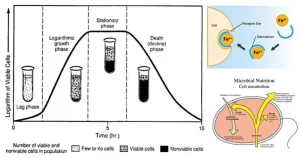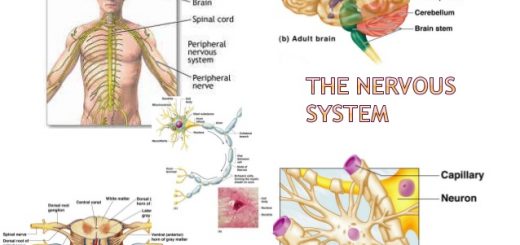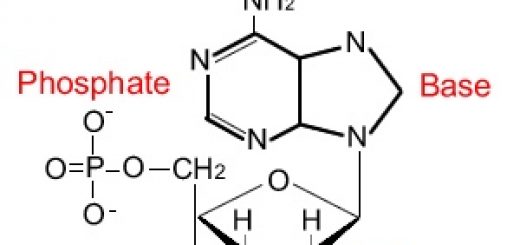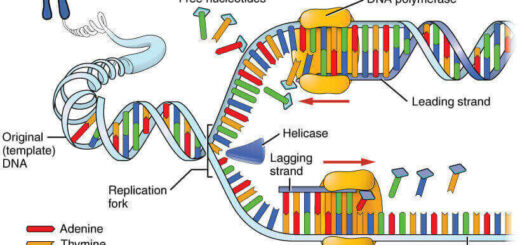Bacterial growth phases and Environmental factors required for bacterial growth
Microorganisms are of diverse sizes, shapes and structures, and live in widely varied, environments. It is thus not surprising that they also differ widely in the details of their physiology, though their biochemical mechanisms in general are similar to those of all living creatures including man.
Bacterial growth
The basic chemical composition of all microorganisms is essentially similar. Water is the main component making up about 80% of the cell’s weight. In addition to proteins, nucleic acids, polysaccharides, and lipids. The main activity of the bacteria as a whole is reproduction, this requires the following:
1. Nutritional Requirements
Nutrients in growth media must contain all elements necessary for the biological synthesis of new organisms: Basic elements such as hydrogen, oxygen, carbon and nitrogen in large quantities with sulphur, and phosphorus in smatter amounts while other elements such as sodium, potassium, iron, magnesium and manganese in traces.
Growth factors: These are essential constituents that can’t be synthesized by the organism and must be provided readymade, Examples of bacterial growth factors are: Amino acids, and Bacterial vitamins.
II. Energy
III. Environmental factors required for bacterial growth
1. Hydrogen ion concentration:
The vast majority of parasitic bacteria grow best at pH 7.2-7.6 (neutrophils), yet some bacteria as lactobacilli are acidophils and can grow at a pH of 4. Other species, e.g. Vibrio cholerae prefer a highly alkaline environment, pH 8.5-9.0 (alkaliphiles).
2. Temperature: Almost all bacteria that are pathogenic to man have an optimum temperature for growth at 37°C (i.e. body temperature).
3. Aeration: Two gases influence the growth of bacteria; oxygen and carbon dioxide. As regards oxygen, the bacteria can be classified into:
- Obligatory aerobes: These can grow only in the presence of oxygen, e.g. Mycobacterium tuberculosis and Pseudomonas aeruginosa. These organisms have a purely oxidative metabolism and molecular oxygen is the final hydrogen acceptor.
- Facultative anaerobes: These organisms can grow in the presence or absence of oxygen though they grow more vigorously under aerobic conditions because of a much higher energy yield. They are supposed to possess two systems of respiratory enzymes, one works in the presence of O2, while the other is ready for anaerobic respiration and fermentation, e.g. enterobacteria and staphylococci.
- Obligatory anaerobes: These organisms cannot grow in the presence of oxygen and require a substance other than oxygen as a hydrogen acceptor, e.g. clostridia, some spirochetes and anaerobic streptococci. In the presence of oxygen poisonous substances are formed, e.g. peroxides and superoxides.
- Microaerophiles: These organisms (microaerophilic) grow best in the presence of little oxygen. Little or no growth occurs in the presence of free oxygen. They usually prefer a relatively high concentration of CO2, eg Campylobacter and Helicobacter.
Carbon Dioxide: All bacteria require CO2 for growth but the amount present in normal atmosphere is usually sufficient (0.04%). A higher concentration, 5-10% is required for many parasitic species notably N. gonorrhoeae, N.meningitides and Brucella abortus.
4. Moisture and desiccation: Four-fifths by weight of the bacterial cell consists of water (80%) as in the case of other organisms; moisture is necessary for growth. Drying in the air is lethal to many microbes, e.g. Gonococci, Treponema pallidum and common cold virus, whereas Mycobacteríum tuberculosis, Staphylococcus aureus and Smallpox virus may survive for weeks or months.
Bacterial growth
Growth is the increase in the sum of all the components of an organism. Cell multiplication is a consequence of growth which leads to an increase in the number of cells making up a culture. A cell may double every 20 minutes, by simple binary fission. Most bacteria can grow on artificial culture media. However, some bacteria e.g. Mycobacterium leprae and Treponema pallidum cannot yet be grown in-vitro, other bacteria e.g. chlamydiae and rickettsiae only replicate within host cells and are grown in tissue culture.
Bacterial growth curve
When a comparatively small number of organisms are taken from a culture and inoculated into a fresh growth medium, the number of cells multiply a million-fold or more. If the logarithmic number of cells present at different times after incubation is measured and plotted in relation to the time, the resultant plot is the growth curve.
Four main phases can be recognized
1. Lag phase:
There is no multiplication of bacteria or even depletion, It represents the time taken for the cells to adapt themselves in the new environment and prepare for division, The duration of this phase varies from few hours to few days depending on the following factors:
- The nature of the organism, E. coli has a short lag phase, may be less than one hour; Mycobacterium tuberculosis has a long lag phase that may be a few days.
- The size of the inoculum, the bigger the size the shorter the lag phase.
- The more suitable the medium the shorter the lag phase.
2. Logarithmic phase (Log), (or phase of accelerated growth): The cell divides by binary fission regularly at a constant maximal rate and in an exponential manner, so that there is a linear relationship between the log of the number of cells and time. In this phase, the bacteria are more sensitive to the effect of antimicrobial agents.
3. Stationary phase: The rate of growth diminishes until the number of cells remains constant, where the number of newly formed cells becomes equal to that dying, This is due to one or more of the following factors:
- Exhaustion of nutrients.
- Accumulation of toxic metabolites.
- Development of unfavourable pH and O2 consumption.
4. Decline or death phase: During this phase, the bacterial population declines due to the death of the cells. The decline phase starts due to: the accumulation of toxic products and autolytic enzymes, and the exhaustion of nutrients. This growth curve draws similarity to what happens to the human being during the course of a disease, the incubation period is similar to lag phase, the log and stationary phases to the acute and subacute stages of the disease and then the stage of decline represents convalescence.
Bacterial spores (Endospores)
Members of several bacterial genera are capable of forming endospores, The two most common are Gram-positive rods: the obligately aerobic genus Bacillus and the obligately anaerobic genus Clostridium, Those organisms undergo a cycle of differentiation in response to environmental conditions: The process is called sporulation, It occurs when there is depletion of several nutrients (carbon, nitrogen, or phosphorus).
Each cell forms a single internal spore (endospore) that is liberated when the mother cell undergoes autolysis (free spores), The spore is a resting cell, highly resistant to desiccation, heat, and chemical agents, When returned to favorable nutritional conditions and activated, the spore germinates to produce a single vegetative cell, Spores play a very important part in the transmission of certain diseases like anthrax, tetanus, gas gangrene, and botulism.
Sporulation: The process of endospore formation within a vegetative (parent) cell is known as sporulation.
Properties of Endospores
- Spore wall, which is the innermost layer, it contains normal peptidoglycan which will become the cell wall of the germinating vegetative cell.
- Spore cortex is the thickest layer of the spore envelope.
- Spore coat confers on spores their relative resistance to antibacterial chemical agents.
- Exosporium.
Chemical composition of spores
The cytoplasm of the spore is in a state of almost complete dehydration. New constituents appear as calcium dipicolinate which is responsible for the stabilization of enzymes against desiccation and heat.
You can subscribe to Science Online on YouTube from this link: Science Online
You can download Science online application on Google Play from this link: Science online Apps on Google Play
Features and classification of viruses, Defective viruses, and Viral vectors used for gene therapy
Microbiology, Bacteria structure, types, Gram positive bacteria and Gram negative bacteria
Pathogenesis of bacterial infection, Classification of Pathogens and Bacterial virulence factors




